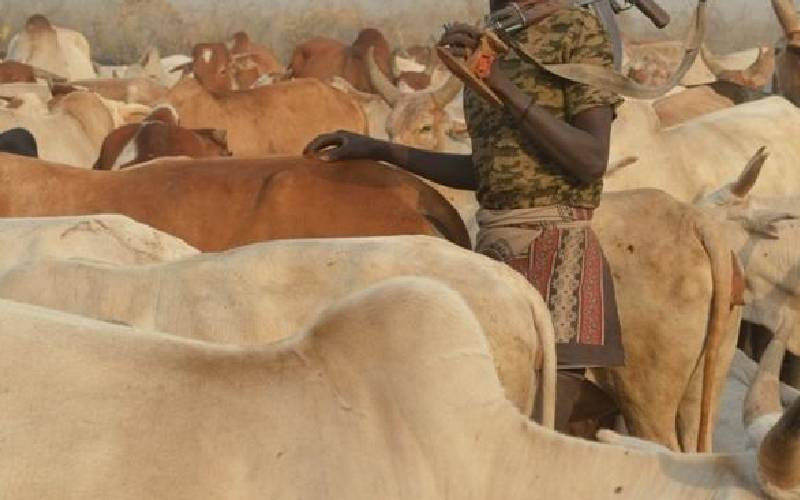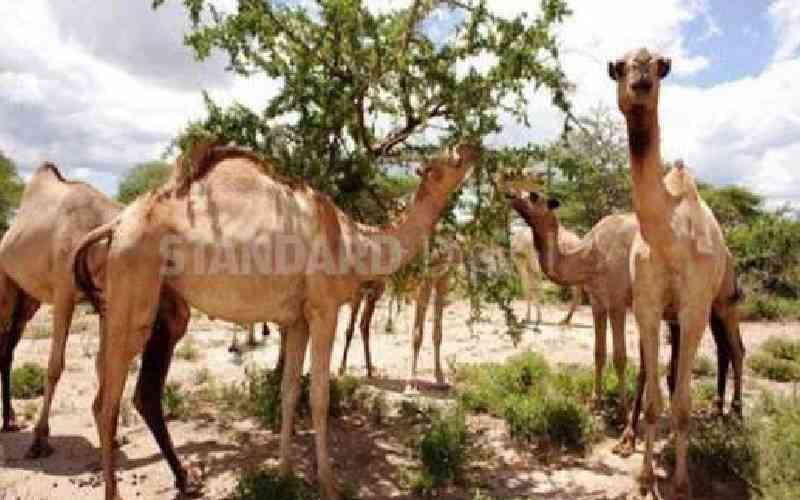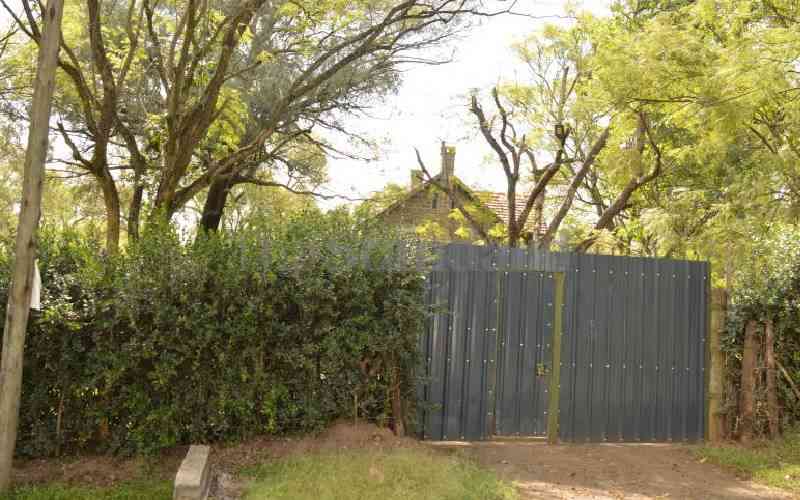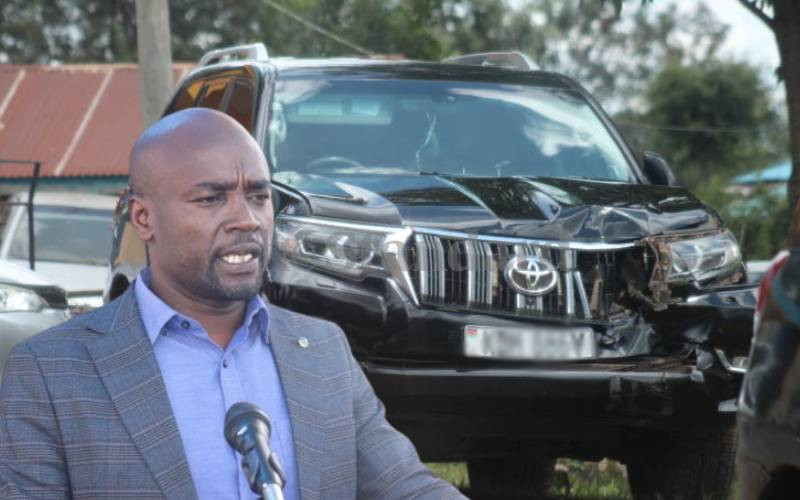
A walk through the cracked dry mudflats dotted with dried papyrus reeds in Rumuruti's Ewaso Narok swamp depicts a wetland on its deathbed.
Nakwakwa Eleo Nakuya, a Rumuruti resident who has watched the expansive wetland shrink over the years, is concerned about its state.
Thousands of people, livestock, and wildlife depended on the swamp for survival. However, Ewaso Narok is on its way to extinction, following in the footsteps of dinosaurs and white rhinos, which were wiped out over time by commercial farming and illegal settlements.
"This wetland was a source of so much water that we used to grow maize just 20 years ago. Then the large corporations arrived with their commercial farming and began milking the wetland dry.
"The small amount of water from Ewaso Narok has been sucked into individual farms via furrows and unregulated water pumps," Nakuya said.
Over 900 hectares of the wetland were covered with papyrus and trees about two decades ago, according to a University of Nairobi research project titled 'Factors Influencing Resource Use Behaviour in Ewaso Narok Wetland.' Today, crops and extensive grazing cover 80 per cent of the swamp.
Lives threatened
Rivers that draw water from the dying wetland are drying up, and the larger Ewaso Narok basin is on the verge of extinction, threatening the lives of thousands of people, livestock, and wildlife.
- What do all these climate words mean?
- Let us broaden our values, reconsider clear-cut logging
- Too much talk on preparedness, we need mechanisms to track progress
- For a sustainable future, let us recognise the urgency of the challenges we face
Keep Reading
River Ewaso Narok, for example, receives water from the Marura wetland and drains into the Ewaso Ng'iro River. However, the river now meanders through drying papyrus reeds before being sucked into roaring pumps and channelled into farms in Rumuruti, Laikipia County.
The contrasting image of lush green fields and drying reeds on the wetland paints a clear picture of Laikipia's largest wetland's gross mismanagement. "The wetland is drying up, and the rivers are unsafe," Nakuya says. His experience is similar to that of his neighbour Miliano Erwata. In 1984, the father of eight moved to Marura.
For him, the wetland is more than just a source of income; it is an ecosystem that nurtures both the environment and his livestock.
"We don't have food, and our animals have died as a result of a lack of water. Most of us cannot afford to practise subsistence agriculture because we lack the financial means to pump water from the river to our farms.
"A lot of water is taken upstream for commercial agriculture," Erwata said.
The National Environment Management Authority recently announced plans to designate Marura wetland as a protected area to protect it from further encroachment, human activities, and deforestation, which has resulted in severe drying up of the water source.
According to the Environment ministry, wetlands account for three to four per cent of Kenya's landmass and are on the verge of extinction because most of them have been degraded to make way for developments.
Ecosystem alteration
Particularly in Marura, high-density small-scale farming has resulted in ecosystem alteration, habitat modification, and the extinction of both wetland and rangeland species.
According to Nema, the swamp is home to over 170 bird species, both migrant and resident, as well as over 100 plant species. However, increased encroachment has resulted in an increase in human-wildlife conflicts.
"If Marura is to be restored to its natural state, the government should begin with the large companies that extract water from the river. The water is insufficient for such high-density agriculture, but thousands of people downstream rely on it for survival," Erwata said.
Rumuruti is one of Laikipia's major breadbaskets due to the main cash crops grown.
According to experts, the disappearance of the wetland will exacerbate the already-harmful effects of climate change because it recharges tributaries that drain into the larger Ewaso Ng'iro river, which serves more than two million people in Laikipia, Isiolo, Samburu, and Wajir before disappearing underground at Lorian swamp in Wajir.
Fragile ecosystem
"Wetlands are a fragile ecosystem because once tampered with, they are easily lost due to disrupted ecological processes. Unfortunately, most people regard wetlands as waste land," said Peter Matunge, the executive in charge of water, environment, and natural resources in Laikipia county.
"We haven't had consistent rain in the last two years. Temperatures are rising, which means more water evaporation on already threatened wetlands," Matunge said.
The county executive added that the Ewaso Narok Swamp Integrated Management Plan 2022-2032, developed in collaboration with the county government, the Food and Agriculture Organization (FAO), the European Union, and Nema, provides for the wetland's long-term use.
The Ewaso Narok swamp is a relic of a once-large number of wetlands, including Pesi, Melwa, Mutara, and Manguo, which were drained in the pursuit of food production and development.
The Manguo wetland is gradually being choked by severe pollution.
According to Mary Wachuka, a local resident, the abandoned Manguo wetland has become a dumping ground for aborted foetuses. It is also a haven for hippos, which gives rise to the name Maanguo, which translates loosely to "place of hippos" in the local dialect.
"The wetland had a lot of water a few years ago, but the levels have now dropped. Because of the hippo attacks, it is now a threat to us. We ask the authorities to fence it off to keep them out," Wachuka said.
Encroachment
Lake Ol Bolossat, a major source of tributaries, is also on the verge of drying up due to increased encroachment.
"The lake's water level is dropping at an alarming rate, but people are still encroaching on it." "You couldn't go near the lake in the 1970s, but now you can easily walk on the cracked water beds," said Samuel Nderi, the chairperson of the Ol Bolossat Water River Users Associations (WRUA).
Nderi said hippo attacks near the lake have increased as the animals invade farms in search of food.Wetlands, according to the World Wide Fund (WWF), are incredible climate change fighters because they act as carbon sinks.
Furthermore, activities to restore the swamp, such as tree planting, cleaning exercises, public conservation awareness, camel caravans, and community forums, have yielded little success.
Environmental activists organise annual camel caravans to advocate for the conservation of the Ewaso Ng'iro basin, which includes the wetlands.Participants in the most recent one by the Indigenous Movement for Peace Advancement and Conflict Transformation (IMPACT) trekked upstream from Ol Donyiro in Isiolo county to Lake Ol Bolossat in Nyandarua, where the river Ewaso Ng'iro originates.
Preservation
"Wetlands are weak pressure points, but they are also suitable for agricultural activities. People are looking at the short-term benefits of growing food, but the long-term consequences of destroying them are enormous and painful," said Mali ole Kaunga, executive director of Impact.Poverty, according to Kaunga, has pushed communities to destroy wetlands for a living through farming, charcoal burning, and settlement advocating for their participation in wetlands protection.
"We must allow communities to participate in the preservation of these natural resources," Kaunga said. For example, the local community has fenced off Kelele Wetland in Kirimon as a result of advocacy efforts. A five-year management plan is being implemented to restore Kelele Wetland.
The management plan for the wetland designated the community as the ultimate custodian of the wetland, in addition to Nema, which has the overall legal mandate to protect the resources.
This story was reported with support from Internews' Earth Journalism Network.
 The Standard Group Plc is a multi-media organization with investments in media platforms spanning newspaper print
operations, television, radio broadcasting, digital and online services. The Standard Group is recognized as a
leading multi-media house in Kenya with a key influence in matters of national and international interest.
The Standard Group Plc is a multi-media organization with investments in media platforms spanning newspaper print
operations, television, radio broadcasting, digital and online services. The Standard Group is recognized as a
leading multi-media house in Kenya with a key influence in matters of national and international interest.











